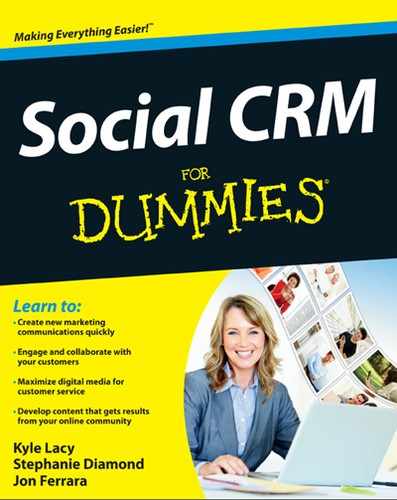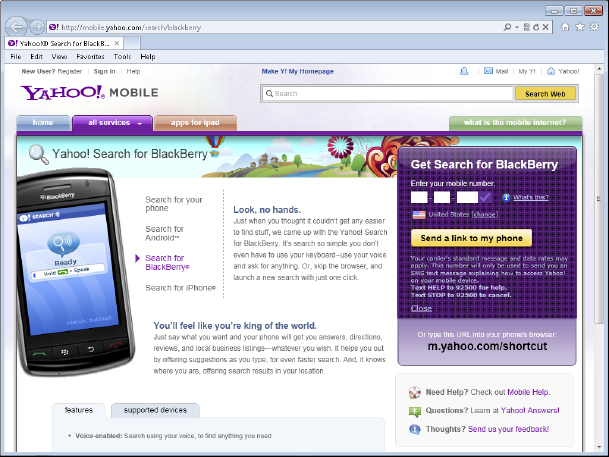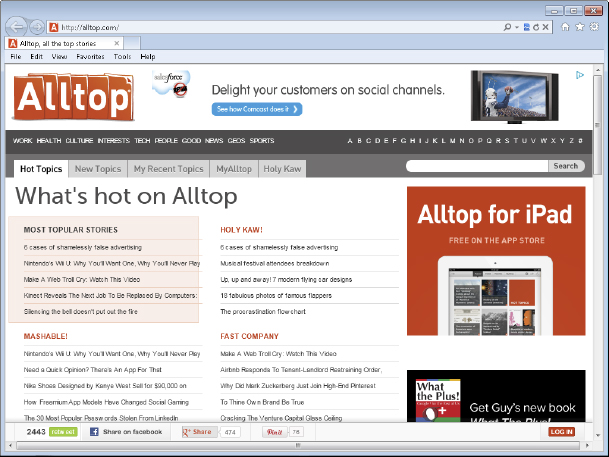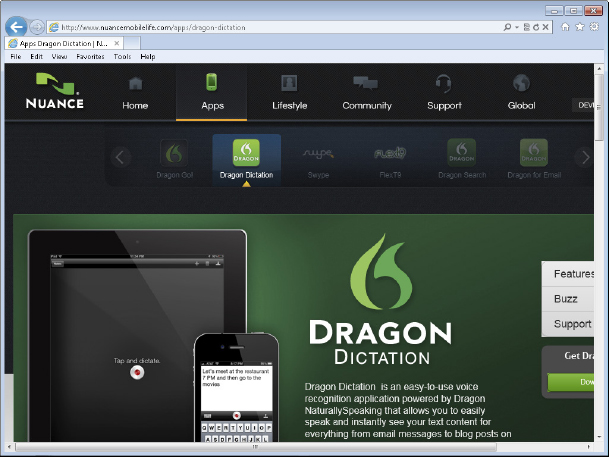Chapter 11
Supporting the Age of Mobility
- Engaging with mobile shopping
- Navigating your day with mobile devices
- Locating recommendations with mobile
- Getting familiar with the mobile enterprise model
- Discovering how mobile impacts employees
- Looking into the future of mobile and social CRM
Got your smartphone handy? If you're like almost 50 percent of wireless device owners, you probably do, according to a Nielsen study. We use our smartphones and other mobile devices like actual companions that assist us in navigating our day.
In marketing, mobile is known as the third screen. We've gone from the first screen (TV) to the second screen (the computer) and now on to the third screen (the mobile device). If anyone is concerned that the previous screens would disappear, they can stop worrying. Mobile users have figured out how to enhance each of the other screens by using them in tandem.
For example, if we're watching a TV show, we may look up the actor's bio on our smartphone. If we want to visit the museum we read about while sitting at our desktop computer, we can get directions while we're on the way from our mobile device. If we want to find a new restaurant, some of us ask Siri (iPhone's mobile assistant) or other smartphone review apps for a recommendation.
Armed with this knowledge, business owners need to make decisions about how to integrate this behavior into their social media strategy. In this chapter, we look at how pervasive mobile devices have become and how they impact your business. As a social CRM user, you can't afford to ignore it. As former CEO of Google, Eric Schmidt has said, “Put your best people on mobile.”
Looking at Consumer Trends in Mobile
It appears that mobile devices are always with us as we go through our day. Research from Microsoft Tag tells us that Americans spend 2.7 hours per day socializing on their mobile device, be it a tablet or a smartphone.
The shocking part of that statistic is that, according to the folks at Microsoft Tag, “it's twice the amount of time they spend eating and one third of the time they spent sleeping each day.” In fact, they predict that by 2014, the global use of mobile devices will overtake desktop web use. (Microsoft Tag is the group that developed the Tag app to produce QR codes and 2D bar codes used in consumer magazines. Find out more at http://tag.microsoft.com/home.aspx.)
The mobile web experience is varied. Some content is hard to see and some has been created to be viewed specifically on a mobile device. To understand how businesses should look at the use of mobile devices, a distinction needs to be made about these two different kinds of mobile experiences:
- The mobile web: This term refers to the Internet viewed from a mobile device. This includes things like surfing the web from a browser or reading a blog. The content may or may not be optimized for a smaller touch-screen device. Either way, the links and scrolling work just as they do on any web page.
- Applications for mobile devices: These are custom software programs designed to assist the customer in viewing specific content. They help access data in a pleasing way or engage with brand content. These applications are specific to the device's operating system. For example, iPhone runs the iOS operating system, and programs have to be written specifically for that system.
 Because of this distinction, businesses have to decide how much effort they want to put into massaging their content for access on mobile devices. Some may elect to create custom apps. Others may decide that their mobile presence doesn't require the extra expenditure because they push much of their content through social networks.
Because of this distinction, businesses have to decide how much effort they want to put into massaging their content for access on mobile devices. Some may elect to create custom apps. Others may decide that their mobile presence doesn't require the extra expenditure because they push much of their content through social networks.
Understanding the needs of the market
To get a clear understanding of your customer's mobile needs, it's helpful to view the results of a study done for Yahoo!'s 2011 white paper, Mobile Internet – Delivering on the Promise of Mobile Advertising. This study (the first in a series) breaks the categories of mobile use into seven identifiable modes and the amount of time each day spent in that mode.
In Table 11-1, we also include a Mindset column. The study linked mindset to each mode. Of course, the consumer could have more than one mindset while using their mobile. The one cited is the most pervasive, according to the study. In the next section, you find out more about how to best reach your customer based on the pervasive mindset.
 The information in Table 11-1 gives you some idea of how to approach a customer who's engaged in a particular behavior (mode). For example, if you're planning to advertise, you may want to avoid placing the ad near GPS data (GPS users are in Navigate mode and tend to be irritated) unless you can really help smartphone users get where they need to go!
The information in Table 11-1 gives you some idea of how to approach a customer who's engaged in a particular behavior (mode). For example, if you're planning to advertise, you may want to avoid placing the ad near GPS data (GPS users are in Navigate mode and tend to be irritated) unless you can really help smartphone users get where they need to go!
Table 11-1 Seven Modes of Mobile Usage
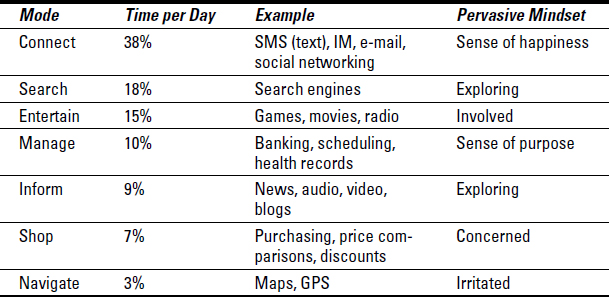
Using consumer behavior to develop mobile campaigns
As a businessperson, you need to figure out how to use the different modes of behavior and the attendant states of mind to reach your customers as they go through their day. For example, if you're a health care provider, you may want to help your customers schedule appointments using their mobile devices. You'll also want to know if your customer demographic uses a mobile device as often as predicted. According to a Nielsen Wire article posted on September 26, 2011, 62 percent of 25–34-year-olds own a smartphone. If that's your demographic, you need to pay attention to mobile.
 You can't create new behaviors in your customer; you want to fit in with what they're already doing. Customers can't even change their own behavior very easily, so trying to change them for your brand is nearly impossible.
You can't create new behaviors in your customer; you want to fit in with what they're already doing. Customers can't even change their own behavior very easily, so trying to change them for your brand is nearly impossible.
Here are some of the behavior modes and how they relate to your mobile strategy:
- Connecting: It's no surprise that connecting is the main way people use their mobile phones. They text, send e-mail, check into their social networks, and instant-message their friends. Your main goal should be to make sure your message is appropriate for the platform.
For example, if you want to engage customers while they're on a social platform, you would send out a different type of customer message than one you send to a business e-mail address. The underlying message would be the same; only the tone and format would be different.
A key takeaway for your campaign: Make sure that your messaging is consistent across platforms. You don't want to confuse your customers. Remember that sales trainers always say, “a confused mind always says no.”
 Even if you have permission to contact a user at his professional e-mail address, remember that he might look at the message from a mobile device, so make sure the experience is good and doesn't waste his time.
Even if you have permission to contact a user at his professional e-mail address, remember that he might look at the message from a mobile device, so make sure the experience is good and doesn't waste his time. - Searching: Searching can be even more important to a mobile user than it is to someone sitting at his desktop. Search results could determine which location he heads to next. In 2011, Google published results of a study, The Mobile Movement, that includes this information: 77 percent of users go to a search engine first when picking up their mobile device. (For more on this topic see Chapter 7.)
- Viewing: When you're creating content for mobile users, you have two choices. You can either develop an app that works specifically with your content or you can make sure your site is maximized for mobile viewing and provide a link to your original site. Check out how your site looks in the major search engines, including Yahoo!, shown in Figure 11-1.
A key takeaway for your campaign: Optimize your site for mobile viewing if at all possible. Make sure customers don't have to go to a competitor's site because they can't adequately view yours.
Figure 11-1: Yahoo! Mobile Search for the Blackberry.
- Entertaining: Mobile users love to entertain themselves while on the go. Standing on a long line at the grocery store doesn't inspire the boredom that it used to. Obviously, major TV and movie content producers will have the bulk of your customers' attention, but users can always text or play a game with a friend. Your business should consider the use of mobile games and contests to help your customers engage with your brand, like Elle Magazine does (www.elle.com/Sweepstakes), as shown in Figure 11-2.
A key takeaway for your campaign: A game or contest with the right message can draw your customer's attention when they want to engage with your brand.
- Managing: When users are managing tasks on their mobile devices, they most often have a sense of purpose. Being able to accomplish something while they're out running errands goes a long way to making them a loyal customer.
Figure 11-2: Elle Magazine sweepstakes.
A key takeaway for your campaign: If you can, help your customer accomplish a task very easily, such as scheduling an appointment or looking up a record of their data. If they can't do it easily, you defeat the purpose of making it available to them.
- Informing: When customers look for news or other types of current information, they may not have a specific topic in mind. It's up to you to help surface the most important content, like Alltop does (http://alltop.com), as shown in Figure 11-3.
A key takeaway for your campaign: Try to aggregate your content so that people can easily scan it for the topics that interest them most. Perhaps you can group your most viewed blog posts together or surface breaking news.
- Shopping: There was a time, not that long ago (in the mid 1990s), when people feared buying something from the web. Shopping carts were faulty, and there were no entities like VeriSign to verify the credibility of an online business. Many shoppers felt that punching in their credit card number online would be chancy at best. Not so today. Thanks to sites like Amazon, shopping can be a care-free affair.
Figure 11-3: Alltop's most popular posts on the iPad.
A key takeaway for your campaign: Make sure that comparison-shopping sites have your data. Mobile shoppers most often access these sites. They take their mobile devices into the stores and use an app that lets them scan bar codes or take a shot of the actual product and find pricing information online. For instance, consumers can use the Google Shopper app (www.google.com/mobile/shopper), as shown in Figure 11-4, to compare prices quickly while they're on a shopping trip.
Another way that buyers can comparison-shop is by using their mobile browser to visit sites like Bizrate (www.bizrate.com).
 One key to shopping behavior online is the type of technology available. One of the technologies currently under consideration by communication companies like Nokia is near field communication (NFC). It's a delineation of standards for companies creating mobile shopping technology for smartphones that requires the phone to tap or be close to the source of the item. What that means is you can complete a transaction by touching or tapping something. Some people call it tap to pay. Technology experts predict wide use of this technology by 2016.
One key to shopping behavior online is the type of technology available. One of the technologies currently under consideration by communication companies like Nokia is near field communication (NFC). It's a delineation of standards for companies creating mobile shopping technology for smartphones that requires the phone to tap or be close to the source of the item. What that means is you can complete a transaction by touching or tapping something. Some people call it tap to pay. Technology experts predict wide use of this technology by 2016.
- Navigating: You know that being found is the lifeblood of any local business. If you rely on foot traffic, look into companies like Foursquare (see the next section for more about Foursquare) to help you reward customers for stopping by.
Key takeaway for your campaign: Make sure that your business's physical location is correct on all popular mapping services, including Google Maps, Yahoo! Maps, and MapQuest. It may not be. If this is the case, alert customers to how they can revise their GPS or other maps to find you. Don't take anything for granted when it comes to mapping. You should also submit the corrected information to the mapping service. They will be happy to correct it.
 A recent Nielsen study found that shoppers use their smartphones differently depending on what type of store they're in. Does this surprise you? Probably not. Each type of store requires you to put on your consumer hat to figure out the way to get the best deals. In grocery, department, and clothing stores, smartphone users typically check for mobile coupons. In electronics stores, they read reviews, compare prices, and scan QR codes. (For more information on this topic see Chapter 9.)
A recent Nielsen study found that shoppers use their smartphones differently depending on what type of store they're in. Does this surprise you? Probably not. Each type of store requires you to put on your consumer hat to figure out the way to get the best deals. In grocery, department, and clothing stores, smartphone users typically check for mobile coupons. In electronics stores, they read reviews, compare prices, and scan QR codes. (For more information on this topic see Chapter 9.)
Not in my store!
Recently, retailers have been struggling to combat a shopping behavior they call showrooming — looking at products in bricks-and-mortar stores and then purchasing them online (through another company) at the best price available. No one can argue with their logic, but retailers don't want to sit still and allow their stores to be elegant showrooms for online retailers.
After much consternation, some retailers have figured out a few ways to combat this behavior. According to an interview in Mobile Commerce Daily, Martin Hayward at Mirror Image Internet says that retailers are testing these techniques:
- Free shipping: Offering free shipping to people who purchase from their app while they're in the store
- Coupons: Providing a coupon that can be scanned at checkout when they buy in the store
- Reduced prices: Providing special terms for items purchased in the store
If you're a retailer plagued by showrooming, you may want to try some of these tactics.
Locating the location-based device
Location figures prominently in the use of mobile devices. If a user is willing to share her location, an app can show her a variety of suggestions about what to do in her current location. She can, of course, also find her way using online maps and GPS apps.
There are four main ways the consumer uses a mobile device with respect to location:
- Checking in: Local retailers are using online check-ins as a way to generate foot traffic to their stores. To check in, a customer logs into one of the location-based services, such as Foursquare (http://foursquare.com). This service allows retailers to reward their customers for not only acknowledging when they're in the store but for engaging with others who also frequent the store. Rewards include badges, discounts, and points.
- Finding local information such as news, weather, and movie schedules: Some businesses provide information specific to their location. If you're a customer who wants to see a movie or attend an event, it's critical for you to get those times in advance. As a business owner, you want to make sure that customers can, on impulse, find your schedules and make plans. To optimize your online presence for mobile users, make sure your site displays information that's relevant to the users’ location, such as showing movie times at the closest theater automatically instead of making customers hunt for that information on your site.
- Getting recommendations: The web has become a recommendation engine. Friends, family and people you've never met tell you their opinions. Most people rely on the recommendations of others (not an establishment itself) to choose a restaurant or hotel.
Google has replaced Google Places with Google+ Local (www.google.com/+/learnmore/local), as shown in Figure 11-5, as a way to get specific recommendations about businesses in your area. For restaurants, they include Zagat ratings so that you can see what other patrons have to say.
- Shopping and discounts: As we discuss earlier, location is one of the key ways that people find products and view them. Offering in-store discounts via mobile phones has become a way of life for local stores.
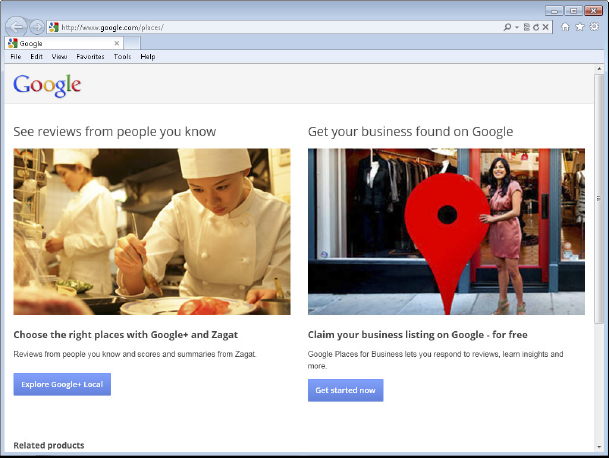
Navigating the Mobile Enterprise
Mobile device use has a strong hold on the enterprise. Your company must become mobile friendly because both your customers and employees already embrace it. The good news is that mobile social CRM has a positive effect on all aspects of customer service in the broadest sense.
During the evolution of mobile devices, several forces came together to make the mobile enterprise a reality, including the following:
- The creation of apps and use of the cloud
- The development of smartphone technology and web standards
- The need to integrate social media and other real-time data
Most people agree that business functions can be enhanced by pushing them out to mobile devices. What they disagree about is which functions and devices should be deployed.
In this section, you look at the issues involved in deploying mobile devices across the enterprise and how that impacts social CRM. The following list looks at what companies are doing with mobile devices to impact social CRM:
- Training employees in the field: Employees used to have to attend a training class at a specific physical location, which might be far away. Now they can get on-the-spot training using iPads or other tablets anywhere they have an Internet connection. This saves time and money.
How this enhances social CRM: Employees have the skills necessary to serve the customer without long trips away from where they're needed.
- Finalizing sales and pricing with the customer: A salesperson would often have to go back to headquarters to get the latest prices, contracts, and approvals. In many cases, the employee can now find that information using a mobile device from a customer's location.
How this enhances social CRM: Customers are better served by their salespeople and can get their purchases in a more timely fashion.
- Managing documents and accessing them from remote locations: If an employee was traveling and needed specific documents, she might have to log on with her computer. Now she can access these documents from a smartphone or tablet without having to lug a heavy computer through airports.
How this enhances social CRM: Customers can have access to documents and other material that will help them use products and services.
Defining the mobile enterprise
When an enterprise goes mobile, it has an impact on every part of the organization. In an AT&T white paper, “The Mobile Enterprise: Moving to the Next Generation,” AT&T lays out these six functions that are affected by mobile usage:
- People: Obviously every employee is impacted. An employee who's given a mobile device has many more options for how he works.
- Processes: Work flow and the types of functions that employees can accomplish at various locations are impacted.
- Operations: This includes not only internal functions but also affects the way the enterprise works with partners, vendors, and so on.
- Systems: Systems affect all the data collected in a variety of databases and any applications created specifically for mobile use.
- Assets: This refers to the devices themselves and the materials and people that support them.
- Customers: Employees can improve customer service and respond to social network data in real time.
Benefitting from mobile
In the case of social CRM, there have been advances in the adoption of mobile devices for sales teams. Companies like Salesforce.com have led the way in developing mobile device applications. Benefits to the mobile enterprise are as follows:
- Employees can work more efficiently and productively. Employees can develop productive habits and schedule work as necessary. Employees can use apps that have been developed by outside vendors to enhance their productivity. For instance, Nuance Communications offers an app called Dragon Dictation, shown in Figure 11-6, that converts your spoken words to text on your smartphone.
- The enterprise saves money. Employees can work in places where working used to be off limits, such as the doctor's waiting room. The enterprise can realize savings from staffers who can work anywhere and at any time.
- Collaboration is easier. Working with teams halfway around the world used to be an impediment. Now employees can work closely with both internal teams and external partners.
Figure 11-6: Dragon Dictation.
- You have access to data and analysis regarding your social media accounts. Your customers are on social media platforms talking about your products. Effective collection of data can be analyzed to increase sales and customer loyalty.
- Real-time interactions with customers are possible. Customers can interact with employees to get the kind of customer service they need.
- Competitiveness can be improved. If your competitors can't react to customer behavior as quickly as you can, you have an enviable competitive edge.
- You can create a faster sales cycle. When your salesperson can instantly produce a contract and your customer can sign on the dotted line, your sales cycle is dramatically improved.
Using mobile with your employees
Employees are heavily impacted when mobile devices are part of the workplace. Companies are also heavily impacted. Therefore, your company has to create guidelines to minimize risk to the company.
As affordable mobile devices for personal use became available, managers and IT policymakers had to decide how to accommodate employees who brought them into the workplace and accessed company systems with them. This gave birth to the concept called bring your own device (BYOD). When an enterprise has a BYOD policy, it means that employees can get approval to use their mobile device on the network. This brings up a host of issues.
When an employee connects his or her mobile device to the company network (or more likely, asks someone in IT do help connect the device), that employee is provisioned (connected) to the network. When an employee is provisioned, the device that he's issued becomes a node on the network, and he's subject to the restrictions and security demands of the company. These considerations include the following:
- Platforms and devices: In order to be provisioned onto the network, employees must use sanctioned devices, most likely paid for by the company. The employee is typically responsible for keeping the mobile account in good standing.
- Security requirements: Each company sets its own security standards, based on its IT needs and capabilities. The security system may require employees to use specific types of passwords and locking algorithms on their devices. When a device is lost, presumably this security should prevent outsiders from accessing data. In addition, mobile data is encrypted so that if the device is broken into, the data doesn't fall into the wrong hands. Companies are constantly monitoring these issues for changes.
- Company data: The enterprise decides what kind of data the mobile employee has access to. For instance, a company might allow a sales team but not a marketing team to access pricing data.
- Diagnostics and repair: If a device fails in some way, employees have explicit instructions about who is authorized to repair the device. If a unit needs to be replaced, the company spells out the guidelines for that.
- Conditions for connection to the network: Employees are given the conditions under which they may deploy their devices. Overseas trips and other special conditions are spelled out. If the enterprise believes there is a security risk, employees are denied access.
So how do employees really use their mobile devices? It's fun to speculate and imagine that they spend all their time on social networks, but the facts don't bear that out. According to Symantec's 2012 State of Mobility Survey, Table 11-2 shows the major ways employees worldwide really use their mobile devices:
Table 11-2 The Way Enterprise Employees Worldwide Use Mobile Devices
Can small businesses compete?
It's not surprising that small businesses have also embraced mobile devices. They don't have to grapple with the many issues that face the mobile enterprise.
For small businesses, the issues of productivity and savings loom large. Mobile devices are a great tool. In addition, mobile devices help small businesses level the playing field. They can create their own apps and interact with customers on social networks as well as or better than larger companies.
According to the AT&T Small Business Tech Poll 2012, when small business owners were asked to rate the importance of mobile technology for their small business, 66 percent said they couldn't survive without it. In a very short time, the mobile device has become a necessary adjunct to any computer. But what do small business owners say about bringing on mobile devices?
In 2012, Web.com Group reported the results of its Small Business Mobile Survey. The report found these three primary motivations for small businesses to use mobile technology:
- Providing better service to customers
- Attracting more local customers
- Gaining a competitive advantage
If you're a small business owner and can't deploy all the mobile marketing tactics you want to, you're in good company. According to the Web.com survey, 64 percent of the small business owners surveyed have a one-person marketing team, thus preventing them from doing all the mobile marketing they would like.
